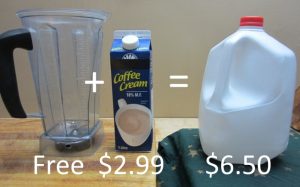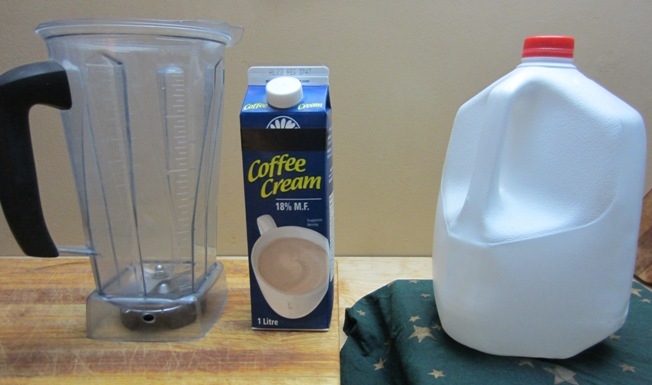Milk and dairy are some of my most troublesome pantry staples when it comes to maintaining both fresh supply and budget integrity up here in market-price-controlled Canada. Tinned evaporated milk can occasionally take the edge off those needs (and makes for better Mac & Cheese anyway) but sometimes you need the genuine fresh article. Just ask my tea. Heaps and heaps of tea. Huge vats of the stuff. Hence the reason I’m always running out in the middle of a blizzard. Since I have no dairy farming aspirations or plans for a pet mini-cow anytime soon, I’m stuck paying through the nose for my weekly supply.
This is likely a problem specific to Eastern Canada so readers farther afield might want to fast forward a post or two. For anyone NOT raised in a public school system, the term “milk money” was used for the few coins you took to school to purchase perishable milk from the resident lunch ladies, one of the few things that couldn’t be packed from home in a brown bag for a meal several hours into the day. I suspect those days are long past but I haven’t taken a brown bag to morning assembly in a while so that’s just a guess.
Anytime government ‘experts’ start meddling in the free market mechanisms you can expect a train wreck. When it comes to my supply of milk for baking and cream for tea, they’ve managed to nearly double the price compared to the west. I know you’re thinking “it must be regional supply issues” but the fact that one of the largest dairy producers in all of Canada is less than ten minutes from my farm’s doorstep should assure you the price padding isn’t because of shipping costs. Thankfully they’ve only managed to maintain this outdated supply management policy on a few key categories like dairy, booze, eggs, and poultry with honourable mention to the maple syrup overlords of Quebec. Wheat was similarly regulated until 2012 when that crumbling system was mercifully abolished after more than 75 years.
The theory is that by price fixing you support the industry. Theory indeed. In practice the small time dairy farmers have been pushed out of the system because the expense of “quota” means you’re fiscally doomed unless you’re one of a handful of the big players. In other words, politicians are protecting the campaign donors. I hate politics as much as sports so that’s where I’ll end my commentary on that front.
That still leaves me with the fact that four litres of ordinary ‘whole’ milk costs $6.50 on an average day with rare sales maybe getting it fifty cents cheaper. Since I can get through that much easily in a week, sometimes more with a lot of baking on the schedule, the incremental costs add up quickly. And that’s before I figure in my cheese-making and butter obsessions which also get an artificial bump in costs under the dairy price racket scheme. I have however found a solution for almost all my liquid needs that will more than halve that cost and all it takes is a jar and a blender. Don’t worry, I’m not going to suggest you start juicing almonds or blending arrowroot. It’s just a bit of milk money and butterfat math.
The anatomy of various milk products is rather interesting. With some notable exceptions of direct purchasing from dairy farmers (something that Nova Scotia has actually outlawed under the guise of ‘safety concerns’), most milk gets sent to a central processor that does two things. First and most importantly it pasteurizes the product to free it from any dangerous pathogens lurking in the mix. Of course there are proponents and detractors of this process with the latter saying natural beasties are nothing to worry since our forefathers had no such concerns. I’m not so sure about that given that what was once a small local cultivation decades ago is now a country-wide game of amalgamating thousands of cows (and thousands of varied farm conditions) into one bottle. On the whole, I’m OK with pasteurization en masse. It’s actually something you can do at home if you have a pet cow but takes some fairly precise temperature management so best let the factories do their thing there.
The second process at the industrial level is a bit more suspect. Homogenization is a mechanical step that shatters the naturally occurring fat in the milk to make it a consistent texture through the whole bottle. That in itself isn’t horrible (unless you’re trying making cheese) and consumers have come to expect that in a bottle of cow juice. Gone for most are the days of cream accumulating on top of the milking bucket thanks to homogenization but never the sort to miss a trick, the dairy industry has come up with a way to skim a bit for themselves off the top and slowly but surely indoctrinate the masses to accept fainter and fainter milk on their tables.
What happens when a tanker load of raw milk from the farm arrives is that most every drop of incoming milk has nearly ALL its fat stripped out leaving behind little more than ‘milk water’. Contained in their giant processing vats and holding silos is liquid with a very faint blue colour and even less fat than ‘skim’ milk sold on shelves. The producers then add a set percentage of fat back into the mix and again mechanically whirr it for consistency. This is why you always see milk marked as a particular percentage of fat despite cows in the wild coming with no such labels. Generally speaking in North America “whole” milk clocks in at 3.25% and “skim” gets a mere half a percent added back. Have you noticed that skim milk is sold at the same price as whole? Butterfat equals profit. Plain and simple. Dairy companies know this and any surplus fat gets funnelled into all sorts of other money makers from butter to cheese to yogurt. Even surplus whey gets dehydrated and sold as an industrial food additive.
While it can vary greatly with breed, diet, and a whole host of other conditions, most cows produce milk in the 3.5 – 4.5% range. See where this math is headed? It may not sound like much in percentages but when you add up the sum total of milk produced and consumed, you can quickly see where the motive lies in skimming just that little extra bit off the top.
Back in the midst of my price war writ small, the usual percentages are found on my store shelves; namely “skim” (.05%), 2%, “whole” (3.25%), light cream (18% – which is oddly named “coffee cream” in these parts), and whipping cream (35%). Out of that line up the least sold is likely 18% from what dairy stocking experts tell me. And by experts I mean the three lads I asked in various stores who lugs the crates from the back room to the front shelves in a seemingly endless loop – “official” industry statistics appear to be more closely guarded secrets thus far. Creatures of habit shoppers all but automatically reach for jugs of their ‘usual’ colour – the tops are colour-coded to match fat percentage – and home cooks have upped the demand for whipping cream it seems. That means fat for fat, my best bargain comes in the 18% formula where one litre costs me $3 on fairly predictable sale cycle or worst case $4 on an off week. Counter-intuitively there’s more fat in that skinny one-litre carton than in the whole of the usual heavy jug, especially if people have been trained to reach for skim versions.
To get myself to ‘regular’ milk for tea, coffee, oatmeal, baking, and nearly every other use I’d have I simply measure 250ml of light cream (@18%) into a one-litre jar and top it up with cold water to land nearer to 4.5% richness in my morning cup of Assam. While entirely usable with just a few shakes of the jar, to really get close to the commercial versions I send the whole lot through the super-blender for about sixty seconds which reasonably simulates factory homogenization.* Certainly anything baked, cooked, or hot and you’d never spot any difference. What little variance might remain is imperceptible and only cold from the fridge straight into a drinking glass might possibly expose the secret formula. And only then in a side-by-side taste test which is not something I’m prepared to do before my first cup three cups of tea in the morning.
* This process is done at the factory using pressure, turbulence, and cavitation by means of a ‘homogenization valve’ on a large scale. Today’s high-powered blenders can come close enough for most tastes but a discount low-power version might not be as good at the task. Ditto on hand-held immersion blenders but your milk mileage will certainly vary with different makes and models of equipment.
Another trick from my mountaintop days for extending short supply lines was to freeze milk out on my -20C balcony after removing a bit for expansion which worked quite well although a post-thaw trip through the blender also helped the finished texture. Really the bigger trouble there was keeping the wildlife from discovering my stash. Raccoons and coyotes really love milk apparently and if the bears woke up early it seems they have serious milk shake cravings first thing after a long nap (ok, it’s more of a milk shred with that bunch). All that freezing trickery is no longer necessary because with cream, you might have noticed the ‘expiration dates’ stamped on cartons are usually considerably longer than regular milk. This is thanks to the higher fat content and can sometimes be as much as a month into the future which gives even me and my hermit ways plenty of time to get past the store between snowbanks.
If there’s any downside it’s that cream products usually aren’t vitamin D fortified like their milk jug cousins so I have to be sure and brave the sunlight at least an hour a day to get my natural production up a bit. Even if it means putting on the parka and walking around looking up at the sun like a newly awoken bear just out of hibernation.
End result, I’m paying half price for my milk in Nova Scotia and mixing a richer blend closer to 4% fat in the bargain. At least until I get a pet cow.


